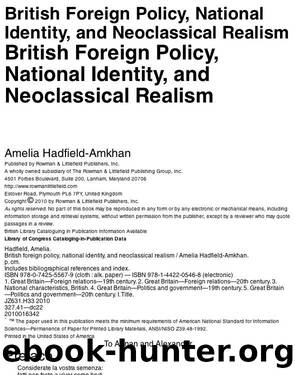British Foreign Policy, National Identity, and Neoclassical Realism by Hadfield-Amkhan Amelia;

Author:Hadfield-Amkhan, Amelia; [Hadfield-Amkhan]
Language: eng
Format: epub
Publisher: Rowman & Littlefield Publishers, Incorporated
Published: 2010-08-15T00:00:00+00:00
Case Study Premise: Political and
Cultural Discourse and Policy Making
The linkages between the public, popular culture, the press, Parliament, and policy now appear concrete. Morgenthauâs maxim that âthe kinds of interests determining political action in a particular period of history depend upon the political and cultural context within which foreign policy is formulatedâ is both vindicated and visible in 1909.160 From 15 October 1908 to the passage of the 1910 âfour-plus-fourâ Naval Estimate, the narrative of identity worked to drive home the need for a policy of eight additional dreadnoughts. The alarm in Parliament, combined with the hysteria in the press, and the centrality of cultural forms that reflected growing national unease over naval weakness constituted the national narrative. Coalesced within the unitary discourse of anxiety, these elements are also causally linked to the reactive policy response of Asquith, Grey, and McKenna.
By 1908, âonly one ingredient was needed . . . to convert public uneasiness as well as uneasiness at Whitehall into a first-class scareâ with tangible policy results.161 Marder identifies that ingredient as âintelligence of German acceleration.â162 This, however, was a secondary process entirely contingent on a prior and permanent blow to English nation-navy identity: the dismemberment of the Two-Power Standard due to the introduction of the Dreadnought. English identity lies at the heart of all such alarms; what had been disturbed was the surety of its principal association between naval supremacy and national greatness. The loss of naval preeminence âinflamed the long-growing public uneasinessâ and gave political voice to the public narrative, âstrengthen[ing] their real oppositionâ into demanding âeight and we wonât wait.â163
To clarify, the surface hysteria of the navy scare is representative of the lack of national self-assuredness and its associated links with the German Other. The roots of the scare itself are however entirely focused upon the prior diminishment of the foundational naval identity at work within the English Self and the security concerns of the British state. A careful reading of the newspapers of the day makes this abundantly clear. In 1904, the Times had recorded that â[n]o phantom as to German aggression haunts us; but the consciousness we feel that it is our duty to watch the progress of German naval power, and to consider the possible purposes for which it might be used.â164 English identity, as examined in chapter 1, was at this point based upon perceptions of tacit, assumed superiority and an ability to exercise national duty by casting a watchful if isolationist eye from the sidelines. However, as illustrated, a change within the domestic identity rather than within systemic forces is equally capable of turning observations of equanimity regarding a rival into sentiments of alarm.
As examined in chapter 3, the greatest threat to identity formation is âa comprehensive alternative identity, an âotherâ that can plausibly be understood as a replacement.â165 A threat such as that experienced by Edwardian England in the dramatic increase of the German navy represents a clear oppositional threat, an obvious juxtaposition of âselfâ and âother.â However, one must question the validity of this easy opposition.
Download
This site does not store any files on its server. We only index and link to content provided by other sites. Please contact the content providers to delete copyright contents if any and email us, we'll remove relevant links or contents immediately.
The Vikings: Conquering England, France, and Ireland by Wernick Robert(79931)
Ali Pasha, Lion of Ioannina by Eugenia Russell & Eugenia Russell(40158)
The Conquerors (The Winning of America Series Book 3) by Eckert Allan W(37149)
The Vikings: Discoverers of a New World by Wernick Robert(36923)
Cecilia; Or, Memoirs of an Heiress — Volume 1 by Fanny Burney(32437)
Cecilia; Or, Memoirs of an Heiress — Volume 2 by Fanny Burney(31873)
Cecilia; Or, Memoirs of an Heiress — Volume 3 by Fanny Burney(31857)
Empire of the Sikhs by Patwant Singh(22977)
The Secret History by Donna Tartt(18852)
Hans Sturm: A Soldier's Odyssey on the Eastern Front by Gordon Williamson(18486)
Cat's cradle by Kurt Vonnegut(15189)
Pimp by Iceberg Slim(14397)
Sapiens: A Brief History of Humankind by Yuval Noah Harari(14254)
Talking to Strangers by Malcolm Gladwell(13229)
Norse Mythology by Gaiman Neil(13211)
Leonardo da Vinci by Walter Isaacson(13189)
4 3 2 1: A Novel by Paul Auster(12289)
Underground: A Human History of the Worlds Beneath Our Feet by Will Hunt(12026)
The Radium Girls by Kate Moore(11927)
